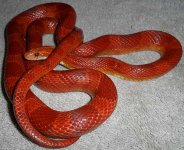NiklasTyreso
New member
So, how much red colour does the parents have?have only done one breeding with the gene. Out of 20 eggs I got 3 positive redcoats and one maybe.
You just got 3 red coat in a clutch of 20 eggs?
Then, if both parents are hets and the gene is recessive you chould have got about 25 % redcoat, you should have got about 5 redcoat hatchlings. That is close to your 3 hatchlings, but are the parents just hets?
If the trait is dominant and the parents are hets then 75 % (= 15 hatchlings) should have been redcoat. Then 50 % should have been hets and 25 % had been homo for the trait. That is far from your breeding result, so it is not likely that your animals trait is dominant.
So, if you cross two red coat animals and get just 3 redcoat hatchlings in a clutch of 20 eggs, then it is most likely a polygenetic trait, a trait depending on two or more genes.



